The lowdown on roosts, roosting and perches with FAQ.

What is a chicken roost?
A roost is the elevated wooden bar, branch or perch where your chickens spend their nights. Roosts satisfy the need of a chicken to feel secure by simulating the branches of a tree where it would normally roost in the wild. Chickens instinctively roost and can become agitated if not allowed to do so.
Below: Roosts in use.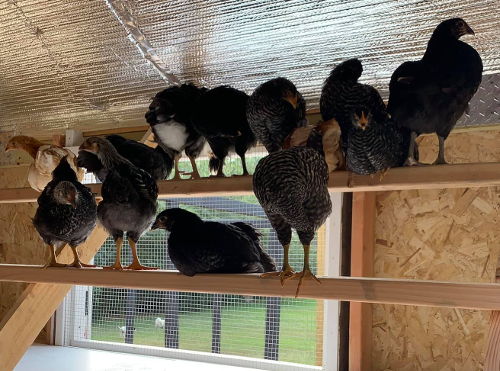
The perch is the bit of wood they settle on to roost. Chickens need around 8 to 10 inches of perch each to roost on.
Do chickens have to roost?
I believe chickens do need to roost for their own well-being. It is a natural behaviour and should be encouraged. Not roosting can be a sign that a chicken is unwell or has been injured.
I use roosts for different reasons, but here are just a few:
- Providing a roost for my birds, gives them a place to sleep rather than pooping all over the nesting boxes when they sleep there .
- Roosting bars allows you to use a droppings board to make cleaning quicker and easier.
- Lack of adequate roosting space can also lead to chickens sleeping on the ground, which increases health risks as birds are more prone to contact with parasites and bacteria.
- Roosting bars are recommended in any coop for the comfort and safety of the flock.
- Coop roosts are provided to fulfil the birds' natural habit of roosting in trees.
- Less risk of smothering each other.
- Less risk of parasites and lice.
It is a chickens natural instinct to protect themselves from predators during their sleep thus they develop the necessity to stay safe by sleeping high up in branches of trees.
Most night time predators are instinctively land predators so being able to avoid their attacks when they are vulnerable is one way of protecting themselves.
Below: Natural wood perches with a poop board.
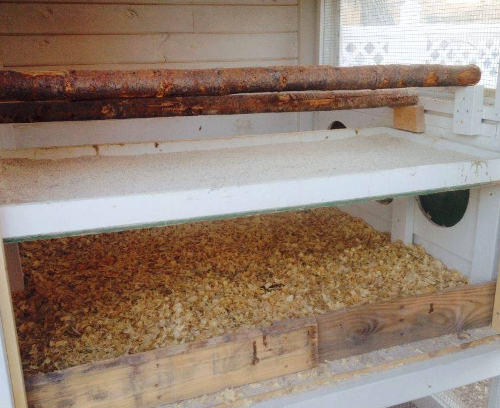
This is one instinct that we cannot alter in order to make our chickens comfortable so we have to give them roosting places accordingly.
Difference between a perch and a roost: A roost is the place a bird sleeps, in our case chickens. A perch is what they sleep on. Roosting is an instinctive behaviour.
How big should a chickens roost be?
Make sure there are no weaknesses in your choice of perch and if you have the choice then go for two or three short perches across the end of the coop rather than one long one down it's length. Bear in mind chickens can be quite heavy and do quite a lot of flapping when they're on perches so they need to be strong.
Below: This perch is a bit thin.
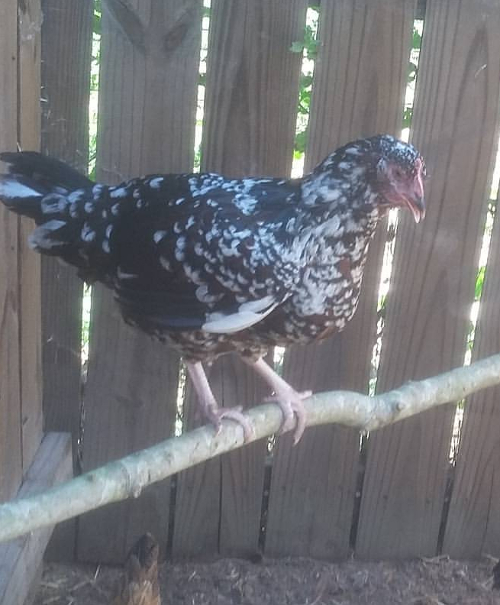
I think the minimum thickness for a roost should be 1 to 1 and half inches. Up to two and a half maximum. I keep all mine within this range and my birds all roost happily.
If you are using bought dowelling then the minimum size for a short (4 to 6 foot) roost is inch and a quarter (30 mm). For longer perches (6 to 12 foot) the size of dowel for a chicken roost needs to be at least 2 inches (50 or 60 mm) and supported in the middle.
The most common perches I see are either 2x2's or 2x4's sanded to remove sharp corners on the top and unpainted. And yes chicken can and do grasp a roost, they are not naturally flat footed. They actually prefer roosting in trees!
Chickens and turkeys left on their own will roost in trees. If using round I would make the diameter a bit larger. Especially if you are in a cold climate. Use what suits you and you can easily get a hold of.
How high should a chicken roost be?
My perches are always at least 4 foot high, even for my Silkies, I just provide them with a ladder. Chickens usually prefer the highest roosts so if some roosts are higher than the others, the tendency would be for the chickens to fight over the highest roosts.
So the best idea is to put all these on the same height and level, about 12 to 16 inches away from each other.
A Perch can be anything from 18 inches high for birds like Silkies or Orpingtons.
Below: These chickens are roosting in the rafters of an outbuilding so the answer is as high up as they can be.

Make sure that all of them are levelled the same height and avoid installing them one higher over the others because you can expect some droppings on the roosts that are below other roosts.
How much space between the roost and the coop ceiling?
You need to leave at least 18 to 24 inches from the roost to the ceiling of the coop.
UK and EU law requires at least 45 cm headroom for chickens.
Place the roosts up high (with maybe some lower jump bars for access). Make the laying boxes as close to the floor as possible. Their instinct is to roost high and lay low. You probably have them too close to the same level with each other.
How far apart should roosting bars be?
Chicken roosts should be spaced 12 to 16 inches apart to allow the chicken to get up to them and back to the floor of the coop easily. Roosting is good for chickens and birds often have their own favourite spot on the perches.
Below: The roosting bars are too thin with not enough room and these chickens need more space.

Its more difficult to achieve this sort of spacing if you are using a ladder system of perches for your flock to roost on. I have tried chicken roosting ladders and ended up removing them.
Should all the roosting bars be the same height?
In my opinion yes. It takes away all the squabbling at bed time over who is having the highest perching spot.
Below: A ladder style of perching system for chickens. I have tried these and prefer to have them all at the same height. Droppings trays are easier to use if the perches are all the same height.

I have tried the ladder type roosts and have found them too low to be ideal and some birds on the top can poop on the ones below. They all try and get to the highest spot anyway so if you have the choice you might as well make them all the same.
What is the best roost for chickens?
There is a myth that because chickens are ground dwelling birds they need and prefer flat perches. The fact is that chickens have evolved to roost in trees and when they have the choice they prefer to have a roost bar they can grab hold off.
Below: Chickens like tree branches so use this as a starting point for your perches in your coop.

I have tested a great many things over the years and chickens choose to roost on round or rounded top bars around 2 inches in diameter.
Should chicken perches be round or square?
Round or rounded top so they can wrap their feet around it.
I have heard it said that round is not the natural for a bird that walks on the ground, well all birds walk on the ground. Wild chickens roost in trees, so do turkeys and they have evolved and managed roosting on round branches for hundred of thousands of years.
Flat roosts will not cause arthritis but sharp edges may increase you chances of bumble foot infections.
Below: This is the most common setup I see as a perch. Just make sure to round of the sharp corners.
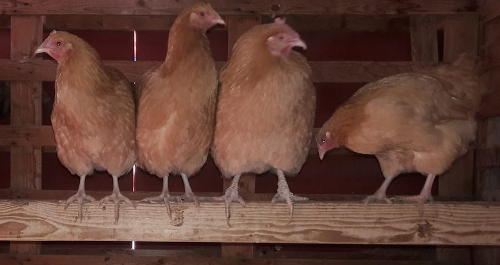
If you use square bought wood then just round the sharp corners off.
What materials can I use for chicken roost?
- Standard wood 2X2's or 2X4's - Most commonly pine but can be anything.
- Branches or saplings cut down and used as natural perches. This is what I use for all my roosts now.
- Bamboo poles. Make sure there are no splinters or sharp buds.
- PVC - Can chickens roost on PVC piping? Yes, but it's not my first choice. It tends to be slippery and bends easily so needs supporting at regular intervals.
- Metal should really be avoided especially if you live in a cold part of the world.
How do you get chickens to sleep on the roost?
I know for some people getting your chickens to use the roosting bars can seem impossible sometimes.
Follow these few simple tips to get your birds roosting properly:
- Cover the nest boxes at night to start with. They shouldn't have access to the nesting boxes at night.
- Use an old hen to show them the ropes. This is my personal favourite and it always works. You can borrow a hen from another keeper if you need to.
- Hang treats at the right height at bedtime so as they fly up to the roosting bars.
- Tame you birds and actually put them on the bars at night.
Naturally raised heritage breeds are more likely to get it right quicker as they've had a mother hen to show them. Hybrids or commercial breeds are raised in huge growing sheds with no perches and may struggle.
What age do chickens start to roost?
Chickens begin to perch as soon as 4 weeks old if they are warm and comfortable. They do not generally begin to roost overnight until 8 to 10 week sold.
Below: A baby chick perching on a brooder edge.
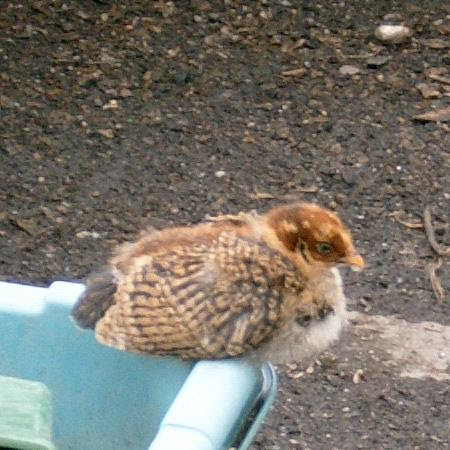
Below: and perching on their mum.
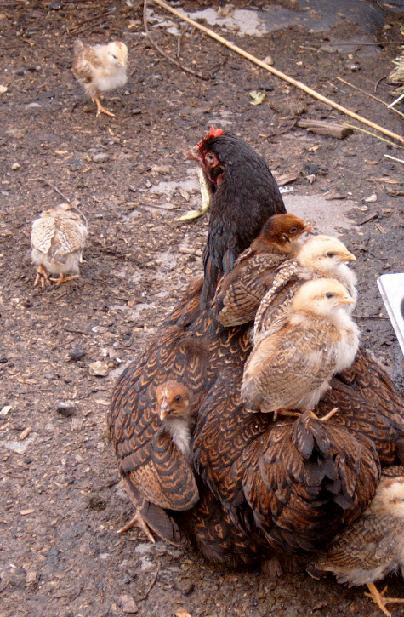
Baby chickens start by roosting either on their mothers backs or by trying to perch on the edge of the brooder.
Do bantams need smaller roosts?
Bantam chickens can have smaller roosts but will be fine on perches that were made for large fowl chickens. If you have a mixed flock then just cater for the largest hens and the littler ones will follow.
Do chickens roost during the day?
Chickens may perch during the day and may even snooze while up on a perch but they do not roost. Roosting is by definition a night-time activity.
Can chickens roost in trees?
They can but you should not allow it. You can stop your flock getting in trees by removing the lower branches.
Below: Some chickens proving they like roosting in trees.
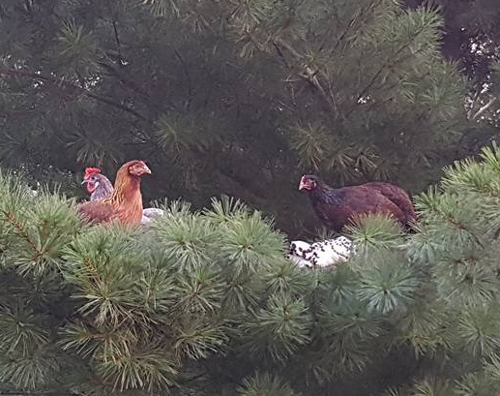
They are much more likely to get eaten by predators or suffer in the weather.
Can roosting bars be too wide?
Yes, chickens need to grip to feel comfortable at night so the bar should be smaller than the foot.
Why have my chicken stopped roosting or perching?
If one of your chickens has stopped perching on the roosting bars for some reason and would only sleep on the ground the check the roosting bars for mites and check the bird for injuries and sore feet like bumble foot.
Conclusion:
In his 1899 book The Australasian book of poultry A. J. Compton says of housing poultry " Housing is of paramount importance if success in poultry keeping is wished for. Fowls can thrive in in very limited space and with the simplest and most inexpensive of surroundings if kept perfectly happy, dry and free from draught"
and he goes on to say:
"Avoid overcrowding. Give proper ventilation and good light as fowls are distinctly averse to occupying a dark or dismal domicile" On the subject off the perch the advice is to "For a few every day common hens, or birds of the heavier breeds, perches made from wooden poles about 6 feet in length (which can be obtained from any furnishing house or drapers), sawn in halves length-ways, and used round side uppermost, will be found the most inexpensive and convenient form of perch procurable : or saplings, three to four inches in diameter, cut in the same manner, will do equally as well. For the heavy breeds the perches should not be higher than from 4 to 5 foot from the ground ; but for the lighter varieties - such as Hamburg, Andalusians, or Leghorns — the height may be increased, and the perches made thinner than those used for the larger breeds."
He also stressed the matter of keeping them clean and in good repair:
"Care must be exercised in keeping the roosts or perches free from grime and parasites, and an occasional application of kerosene oil, or a teaspoonful of Calvert's No. 5 Carbolic Acid"
Most of these things are not readily available these days but suitable products can be found.
